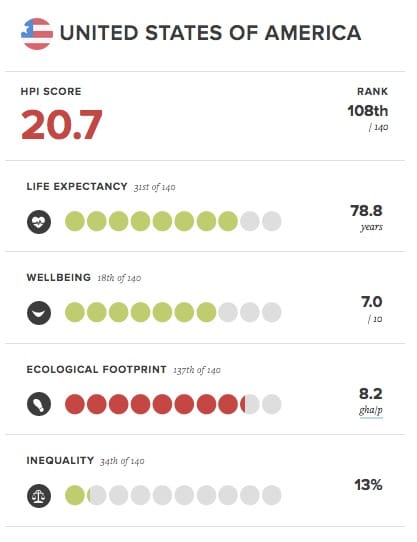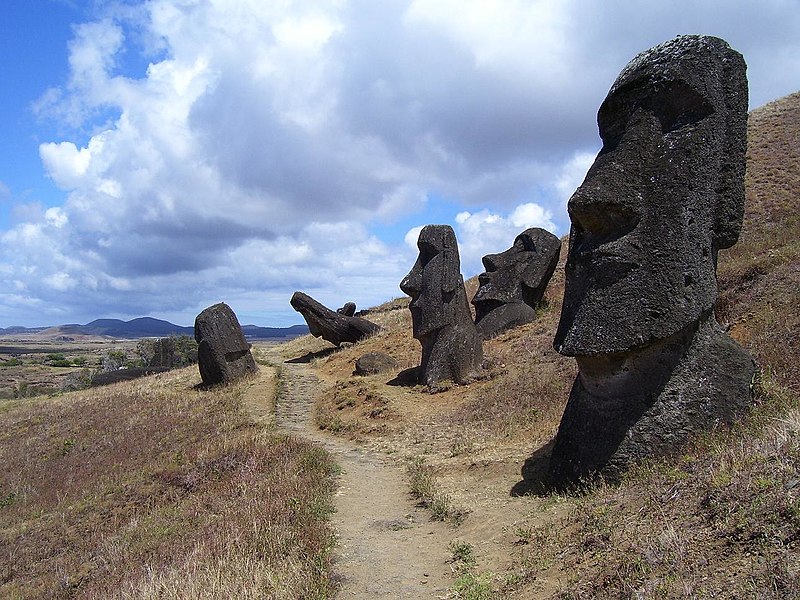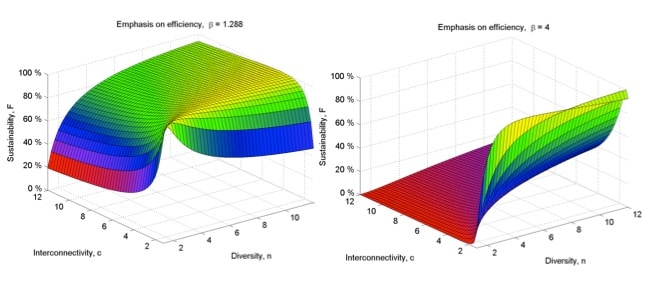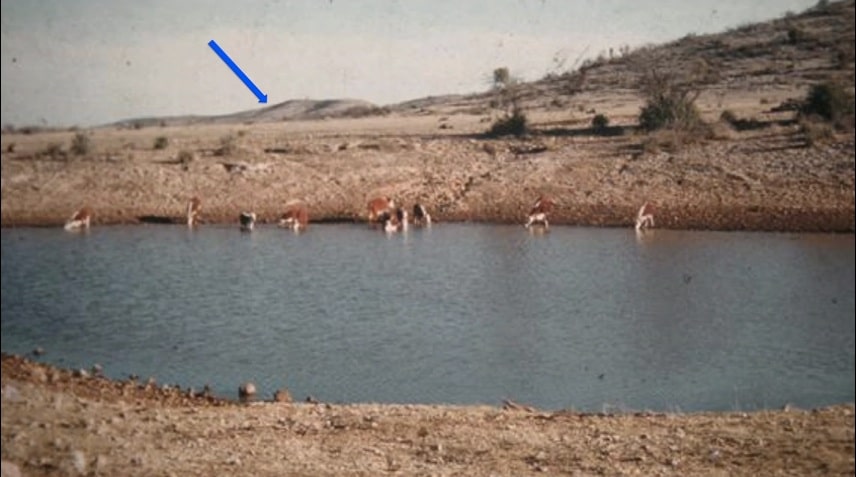For those who like to put things in context, read this short post covering the big picture of One Planet Thriving.
The point of life is sustainable well-being: happiness, health, and long lives achieved in a way that can be sustained over multiple generations. That means we have to achieve our well-being while using only one planet’s worth of resources — that’s what “one planet thriving” means.
In America, we currently use 4.5 planets worth of resources

(2007 EF data, published in 2010). Though we rank #1 for life expectancy, and #18 for well-being, our massive use of resources means that we rank #137 (out of 140 countries) in the world for sustainable well-being (see this New Economic Foundation Report, 2012). Furthermore, we distribute those resources very unequally (the top 20% get nearly 85% of them), a distribution that most Americans find unfair (see this post).
But, unfortunately, status quo is even worse than that. Our current way of life (this is not specifically the U.S. way of life but any country that consumes in similar ways) is actually the largest, most unethical failure in human history. To understand why, we need not delve deeper than the data behind the Doomsday Clock from the Bulletin of Atomic Scientists, a clock created in 1947 that represents 12 midnight as the destruction of the world. As of 4/29/17, we were at to 2.5 minutes to midnight due to concerns about nuclear threats, climate change, biosecurity, and other threats. As of January, 2020, we’re at 100 seconds to midnight. There are other approaches to understanding human contributions to the destruction of the human species.
Question: What does the following list represent?
- deforestation and habitat destruction (50% forests gone, [1]; losing species faster than last 65 M years [3])
- soil problems: erosion (6 bushels soil lost/bushel wheat), salinization (1/3 land affected), & soil fertility losses (40% desertified in Africa — see this TED talk by Allan Savory, who estimates that 2/3 of the world is becoming desert, and claims that desertification is happening more rapidly in the U.S. than in Africa; he also talks about solutions) [2]
- water management problems (water tables and quality declining [1])
- overhunting (humans have hunted to extinction many species on all continents)
- overfishing [90% large ocean predators gone in last 50 years [1])
- effects of introduced species on native species (Millions imported yearly. 400/1352 endangered native species threatened [6])
- human population growth (76M/year. Rate = 1.09%, We’ve hit 7 billion [7])
- increased per-capita impact of people (4.5 planets worth [see above])
- climate change and resulting environmental refugees. 95% sure it is caused by humans and “the particular politics of one country [the U.S.] for one half-century will have changed the geological history of the earth.” (quote from 2018 New Yorker article by Bill McKibben, an excellent summary of this issue.) For other details, see IPCC 5th Assessment Report, 2014 (next version will be
published in 2022) and a special IPCC report published in 2018. For effects on regions in the United States, see the Fourth National Climate Assessment (2018).
- buildup of toxic chemicals in environment (unknown health consequences for many. Known effects on cancer, reproduction, birth defects, brain development [4-5]). See this article for more details.
- energy shortages (End of cheap fuel with no equivalent alternative…again, so much written about this, no point in citing)
- full human use of Earth’s photosynthetic capacity (“Humans are already using 40% of all the ‘plant biomass’ produced by photosynthesis on the planet” [3])
- economic fragility (see this article and also read Nobel prize-winning economist, Joseph Stiglitz, Nicole Foss, and Chris Martenson) and inequitable distribution of power/resources
- the use of weapons of mass destruction, including nuclear weapons
- the re-emergence of infectious disease [8]
Sources: [1] State of the World Report (2004); [2] Permaculture in a Nutshell (2009); [3] www.sciencedaily.com/releases/2011/05/110518131427.htm; [4] ewg.org; [5] In Harm’s Way, www.preventingharm.org; [6] www.ucsusa.org/news/press_release/congress-may-ban-dangerous-0224.html; [7] CIA World Fact Book; [8] including invasive fungal disease, vector borne and zoonotic diseases, opportunistic pathogens, and drug-resistant microbes – Dr. George Mejicano, UW-Madison, Green Medicine Conference Presentation (2008)
See also, p. 555 in Permaculture: A Designer’s Manual by Bill Mollison for a not-fully overlapping list (including, for example, the need for a global response to environmental refugees), an affirmation that those problems have solutions, and then a list on page 556 of suggested bioregional solutions for predictable climate-related cycles.

This is a list of causes of societal collapse (see Jared Diamond’s book on Collapse for list and discussion of #1-12) and they are all occurring. The first 8 are old as time and have been responsible for past societal collapses. The rest are new and we could probably add more to the list.
Does that mean we are in a place of collapse right now? Yes. See this article from someone who has lived through collapse for more.
But notice something important: only a few of them are necessary to create a collapse. That means, you don’t have to believe all of them. Pick the ones that seem reasonable and for which there is indisputable proof…you’ll still have enough causes of collapse to elicit concern. By the way, choosing what you believe is happening can help increase your resilience. While most of the world is trying to avoid being “too negative” (see this article on the difference between negative and unpleasant) or “too doom-and-gloom”, there is some question about whether civilization as a way of living is sustainable (this article offers a sobering review of our problems and this article explores the idea that civilization as a way of organizing human activity is unsustainable and presents data on how long civilizations last). Books like The Great Reckoning have another take on similar themes but more focused on what’s happening now. The 2016 election of a psychopath to the presidency is interesting to note in this regard. This May, 2020 article inspired by COVID-19 is another overview of issues.
Given that the essential purpose of a culture is to digest and pass on to the next generation best practices for thriving, our current culture is the largest, most unethical failure in human history. We are passing on a set of fragile practices that increase suffering and cannot be sustained.
A point eloquently made by Thomas Homer Dixon in The Ingenuity Gap is that complex systems can collapse unpredictably and catastrophically without warning — that is, they can be fragile (see this article on resilience). Dixon illustrates the point with a true story about an airline crash. One engine’s fan blade had been manufactured with tiny flaws. Only after years of use did these flaws grow into tiny cracks, missed by regular maintenance inspections. After thousands more rotations, the cracks became fatal and, all of a sudden, a very good flying machine was experiencing catastrophic failure. Furthermore, the problem defeated all of the airplane’s safety redundancies. This left the pilots with no control over the plane and even people conferring with them on the ground could not help. Under the stress of the situation, further systems were also put under stress, such as the ability for the pilots to cooperate, stay calm, etc. In the end, the pilots claimed incredible luck in being able to crash land the plane, losing only a portion of the plane’s hundreds of passengers.
This crash was the product of many, tiny, but interrelated variables going wrong at the same time. It doesn’t happen often, but when it does, it’s not good (2016 U.S. Presidential Election of a psychopath apply here?). The same can be said of the variables represented by the list above on causes of collapse. The question is not whether to do something about them, but how. Even if one does not believe all of these are occurring, there will be plenty left over to cause societal collapse at some degree of severity. This might range from the types of collapse experienced by Native American peoples from disease and genocide to Rwanda style collapse to Detroit (or Spain or Greece) to the Great Depression. Collapse can happen quickly or slowly and end with total or partial collapse. For example, in the space of 60 years, Easter Islanders went from the production of their largest statue (think largest building) to cannibalism, a military coup, and a new Island religion (the “Bird Man Cult”).
In speaking of societal collapse, Professor Jared Diamond says that his students at UCLA often ask: Why didn’t the people in these societies do anything? I believe there are three reasons: (1) Ignorance: people simply didn’t know that things like soil problems were occurring (too slow and not readily observable), and (2) Avoidance: people either would not or could not change in the ways necessary to prevent the collapse of their society (see this article on avoidance vs. intimacy strategies), and (3) Busyness which prevents remediation of the first two. The Greenland Norse, a culture highlighted by Diamond, could have imitated the sustainable practices of the Inuit but, instead, continued to think and behave like Europeans (with some racism involved), and probably ended up eating each other as their last — and best situated — ranch was over-run by starving compatriots. A good reason to avoid thinking about societal collapse is to avoid feeling anxious. This is reasonable too if there’s nothing we can do about it anyway! Compare someone trying and failing to build a new lifeboat on the Titanic to someone dressed in a Tuxedo and toasting champagne as the Titanic went down.
Let’s pretend for a moment that climate change is real and is caused to some degree by human factors (and thus under our control to some extent). Notice that we’re not ignorant of climate change. The vast majority of scientists provide convincing data. However, avoidance is a strong pull: rather than actually change our status quo, we simply deny there is a reason to. That denial helps reduce our anxiety (see this post on the Dark Side of Optimism).
“The Sky is Falling”: Ridicule is often brought to bear to support avoidance. “Chicken Little has been saying the sky is falling for years.” This misses the point that (1) no one is talking about the sky falling; it is talk about societies collapsing, (2) societies have collapsed many times (unlike the sky), and (3) the historical causes of those collapses are currently occurring. Imagine, though, a coal miner who ignores or ridicules his canary instead of vacating the mine because it is filling with deadly methane gas (see this 3 minute musical riff on the idea). For a contrary point of view, see this Wired Magazine issue dedicated to “Apocalypse Not“.
It takes courage to consider these scary possibilities. Whether we decide to do anything depends on, (1) our view of the costs and benefits of action, (2) on the probability that something unpleasant (in this case, collapse) will come to pass, and (3) when it might occur (tomorrow or 60 years from now). No one can predict the future, much less the depth and timing of potential collapse. The real question is how to deal with uncertainty (think resilience and spreading your eggs in multiple baskets).
And, volatility. There is manifest and latent uncertainty. When uncertainty is made manifest it demonstrates (often after the fact) the need for more resilience. For example, it might be more “efficient” to grow hundreds of acres of one variety of spinach. We become experts at that varietal, work with nice economies of scale, and produce spinach more efficiently than my polyculture neighbor down the road who grows many varieties of many different plants, from spinach to chestnuts.
My neighbor works much harder (or maybe not…consider permaculture forest gardens) for his food. But, which system is more resilient? What happens when a disease comes through? The monoculture farmer hopes it will not target his one variety of spinach. If it does, he’s wiped out whereas the polyculture farmer will only lose that one variety of spinach. It doesn’t have to be a disease either. Suppose Spring comes early and one variety of spinach is heat-sensitive and thus bolts prematurely while another produces in warmer weather. This volatility in weather can only be responded to by spreading our bets (diversifying), in this case among multiple varieties of spinach. Finally, consider the possible inverse relationship between efficiency and resilience as suggested by the curves pictured below: At high efficiency, there is fragility or low resilience (e.g., consider just-in-time inventory when a storm hits); at high resilience, there is low efficiency.

A sustainable life necessarily means a resilient life: not putting all our eggs in one basket. We buy fire insurance not because we believe a fire WILL come or even have any idea of WHEN, but because it CAN and, if it does, it could really mess up our lives. Fire insurance has a cost and may never be needed. But, if there is a fire, it could make all the difference. Obviously, people make the calculation about whether the potential benefits (e.g., peace of mind, the lack of financial ruin) outweigh the costs (e.g., monthly payments for the insurance, the anxiety that might come from considering a fire).
In a way, the main point of this article is not to convince anyone that collapse is happening, but that it CAN happen. It is a reasonable possibility. It cannot be ridiculed away. Given the possibility, how you choose to respond is, of course, up to you.
Responses tend to fall into the following sometimes overlapping categories (from most to least popular):(1) Denial, distraction, and avoidance(2) System change through the usual system channels (e.g., political action)(3) Prepping (see * below)(4) Withdrawal from the systems(5) Radical system change (ala Derrick Jensen)Combinations are definitely possible. For example, developing a lifeboat property or community during your free time (#3 & #4) while working to change environmental laws through status quo channels (#2) while living in a status quo life during the week (#1 or maybe just what we have to do).
* Check out this fun rap song written by a neighbor and a friend who calls resilience folks, “Doomsday Preppers”. WARNING: explicit lyrics.Here’s a prepping approach to triaging what you decide to do:(1) List priorities(2) Assign importance from least important (#1) to most important (highest # on your list)(3) Rate the ease of dealing with these priorities from easiest (#1) to most difficult (highest # on your list)(4) Calculate your “Best Value Score” by dividing the importance by Ease. You can think of this as your “biggest bang for the buck score” with the highest scores representing the best use of your time/money. Sort the list by the Score in descending order and do them in that order.The following table illustrates the idea.
| Importance | Ease | Score | |
| Financial security | 5 | 2 | 2.5 |
| Water | 2 | 1 | 2.0 |
| Fuel for heat and cooking | 4 | 3 | 1.3 |
| Food | 3 | 4 | 0.8 |
| Physical security | 1 | 5 | 0.2 |
In our community, it took about two meetings to agree on priorities to pursue. For more on prepping, see this article on 9 prepping priorities.


Pingback: Financial Resilience | Sustainable Well-being
Pingback: Short-term resilience: Disasters | Sustainable Well-being
Pingback: Unrealistic Optimism: The dark side of looking on the bright side | Sustainable Well-being
Pingback: Our Budget: Ways of Measuring Our Impact | Sustainable Well-being
Pingback: Saving Our Children: Connecting to Ourselves for Sustainable Well-being | Sustainable Well-being
Pingback: Money, Wealth, & Inequality | Sustainable Well-being
Pingback: Short-term resilience: Disasters | One Planet Thriving
Pingback: Intimacy Strategies for a Thriving Me, We, and Big We | One Planet Thriving
Pingback: Life Design: Introduction | One Planet Thriving
Pingback: Thriving on One Planet: The Big Picture in 123 Words | One Planet Thriving
Pingback: One Planet Thriving
Pingback: Solutions for a Functional Future | One Planet Thriving
Pingback: The Great Courses: Human Prehistory and the First Civilizations – Donal’s Notes | One Planet Thriving
Pingback: Levels of Resilience | One Planet Thriving
Pingback: Thriving on One Planet: The Big Picture | One Planet Thriving
Pingback: What is civilization, is it sustainable, and how long do civilizations last? | One Planet Thriving
Pingback: Trump and Societal Collapse | One Planet Thriving
Pingback: What is Permaculture? | One Planet Thriving
Pingback: The Canary: A New Symbol for Gratitude | One Planet Thriving
Pingback: Robin Hood & Other Ethical Cheating | One Planet Thriving
Pingback: Short-term resilience: Prepping for Disasters | One Planet Thriving
Pingback: Reflections on my first summer at Troy Gardens Cohousing | One Planet Thriving
Pingback: Believing A Lie: Goethe, The 100th Monkey, & More | One Planet Thriving
Pingback: Top Tips for Homeowners Embracing an Eco-Friendly Lifestyle | One Planet Thriving
Pingback: Being on the Edges | One Planet Thriving
Pingback: 9 Prepping Priorities | One Planet Thriving
Pingback: Stirling Engines – Notes | One Planet Thriving
Pingback: Spoon carving – Notes | One Planet Thriving
Pingback: Real Communication: The Empathy Dialog | One Planet Thriving
Pingback: Alcohol: A Renewable Energy that Sequesters Carbon and Can Power Our Lives? | One Planet Thriving
Pingback: Be kinder than necessary, everyone you meet is fighting some kind of battle. | One Planet Thriving
Pingback: What is civilization, is it sustainable, and how long do civilizations last? | One Planet Thriving
Pingback: The Four Horsemen of a Relationship Apocalypse | One Planet Thriving
Pingback: Food Storage | One Planet Thriving
Pingback: Rocket Stoves & Rocket Mass Stoves (& Wood Stoves) | One Planet Thriving
Pingback: Open Source Ecology – Global Village Construction Set | One Planet Thriving
Pingback: NewenHouse | One Planet Thriving
Pingback: Unpleasant Positive & Pleasant Negative | One Planet Thriving
Pingback: The Four Principles of Sustainable Life | One Planet Thriving
Pingback: Fired Up: Wood vs. Natural Gas (vs. Rocket Stoves) for Environmental and Personal Health | One Planet Thriving
Pingback: The Dehumidifier Does My Laundry | One Planet Thriving
Pingback: Life Designers | One Planet Thriving